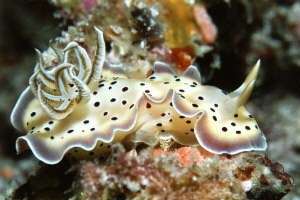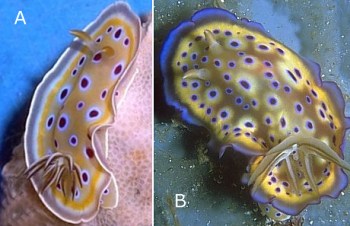

Chromodoris tritos
Yonow, 1994
Order: NUDIBRANCHIA
Suborder: DORIDINA
Superfamily: EUDORIDOIDEA
Family: Chromodorididae
DISTRIBUTION
Maldive Islands.
PHOTO
UPPER: C. tritos, Ellaidhoo Island, Maldives. size 4 cm, PHOTO: Erwin Koehler.
LOWER: For comparison here are photos of: A, C. geminus, Tanzania; PHOTO: Bill Rudman. B, C. kuniei, Great Barrier Reef, Queensland, PHOTO: G. Avern.
This animal has been recorded a number of times from the Maldives, off the southwest coast of India. In external shape and colour it is very similar to Chromodoris geminus, found only in the Indian Ocean, and Chromodoris kuniei, found only in the western Pacific. As I have reported earlier (Rudman, 1987) their ranges overlap in the Indonesian Archipelago, both species being found at Christmas Island.
The Maldives animal could be a pale colour form of either species. However Yonow, considers it to be a distinct species which she has named C. tritos. The only point of difference she notes concerns the morphology of the radular teeth. In the other two species, the outermost teeth are shorter and have a rounded tip. In C. tritos she states that scanning electron microscope photos show that the outer lateral teeth retain the hook shape of the inner teeth, rather than shortening and rounding off as in the other two species. However her photos suggest that the edge of the radular ribbon has curled under during the preparation of the SEM mount and rather than viewing the outermost teeth we are looking at some of the 'normal' inner teeth. At this stage I am not sure that C. tritos is a good species. I suspect it is a pale form of C. geminus.
Yonow (1994), refers to a letter of mine in which she says I record C. tritos from the Seychelles and from Christmas Island (Indian Ocean). I did not expect my correspondence to be interpreted this way, as neither of the finds I referred to in my letter applied to Yonow's colour form or species. The Seychelles record is an unidentifiable juvenile, and as I have reported earlier (Rudman, 1987) typical forms of both C. geminus and C. gleniei occur at Christmas Island.
References:
•Rudman, W.B. (1984) The Chromodorididae (Opisthobranchia: Mollusca) of the Indo-West Pacific: a review of the genera. Zoological Journal of the Linnean Society 81: 115-273.
•Rudman, W.B. (1987) The Chromodorididae (Opisthobranchia: Mollusca) of the Indo-West Pacific: Chromodoris epicuria, C. aureopurpurea, C. annulata, C. coi and Risbecia tryoni colour groups. Zoological Journal of the Linnean Society, 90: 305-407.
•Yonow, N. (1994) Opisthobranchs from the Maldive Islands, including descriptions of seven new species (Mollusca: Gastropoda). Revue fr. Aquariol., 20(4): 97-130.
Rudman, W.B., 1999 (October 16) Chromodoris tritos Yonow, 1994. [In] Sea Slug Forum. Australian Museum, Sydney. Available from http://www.seaslugforum.net/find/chrotrit
Related messages
Re: Chromodoris tritos
October 20, 1999
From: Erwin Koehler

Bill,
here is one more Chromodoris tritos from the Maldives, Ellaidhoo Is., divesite "Orimas Faru", size 2 cm, depth 14, date Nov. 1996.
I saw about 10 specimens at Ellaidhoo. Two of them had black spots and smaller red ones. I don't know if Chr. geminus is reported with red spots.
Erwin
Medslugs.Koehler@t-online.de
Koehler, E., 1999 (Oct 20) Re: Chromodoris tritos. [Message in] Sea Slug Forum. Australian Museum, Sydney. Available from http://www.seaslugforum.net/find/1441
Thanks Erwin,
I have arrowed the two red spots in your photo. Because of the nature of the pigment involved in the dark brown/purple spots of these animals, when pigment density is low the spots appear red or reddish brown. This can often be seen in juveniles, but also in adults. I have seen this in Chromodoris kuniei, and you can see it in photos of juveniles on the Chromodoris geminus, and Risbecia tryoni pages.
Bill Rudman.
'Chromodoris tritos' from the Maldives
October 19, 1999
From: Erwin Koehler

Bill,
Here is Chromodoris tritos from the Maldives, Ellaidhoo Island, housereef, November 15, 1996, size 4 cm, depth 17 m.
Erwin.
Medslugs.Koehler@t-online.de
Koehler, E., 1999 (Oct 19) 'Chromodoris tritos' from the Maldives. [Message in] Sea Slug Forum. Australian Museum, Sydney. Available from http://www.seaslugforum.net/find/1431Dear Erwin,
Thanks for the photo. As I discuss above, I am in two minds about whether this is a distinct species or not. The Maldives seem to have a very interesting fauna. Any more photos from there would be welcome.
Bill Rudman.
